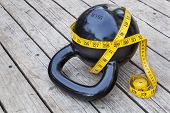
While considered by many as a modern training phenomenon ‘kettlebells’ are, in fact, steeped in history and are long established training tools. As well as being able to perform similar lifts as performed with barbells and dumbbells there are many more kettlebell lifts that can be used to get great results. I personally use kettlebells with my clients on a regular basis and find them to be great cardiovascular training tool.
What is a kettlebell
A kettlebell is a traditional Russian cast iron weight that looks like a cannon ball with a handle; essentially a Russian dumbbell.
Kettlebell weights?
The recommended starting weight for men should be around 16kg, progressing to 20-24kg or more depending on the exercise.
The recommended starting weight for women should be around 8kg, progressing to 10-12kg or more depending on the exercise.
Kettlebell training
Kettlebells are viewed by many (including myself) as the ultimate conditioning tool. Kettlebells can be used to develop and improve:
- Strength and power
- Hypertrophy (bodybuilding)
- Muscle endurance (toning)
- Core function
- Sports performance
- Active flexibility
- Cardiovascular fitness
There are a number of lifts utilised in kettlebell training that target the posterior kinectic chain; these include:
- Erector spinae
- Gluteus maximus
- Hamstrings
These muscles are some of the biggest and strongest muscles involved when performing big lifts. The posterior chain is important for sports performance as it is fundamental to generating forward motion and acceleration. The posterior chain drives performance in jumping, sprinting, throwing, kicking and punching.
Many of the exercises involve integrated movements, that is, strengthening groups of muscles rather than just one at a time. There are also many exercises that include the different planes of motion – sagittal (forwards or backwards), frontal (side-to-side) and transverse (rotation). The lifts, therefore, are great for developing whole body strength and improving motor skills for many every day activities and sports.
Improving core function
Kettlebells can improve the function of the core, since the core has to support and stabilise the trunk during kettlebell lifts. This improvement in core function can play a significant role in preventing conditions such as lower back pain.
Flexibility improvements
Having a good static range of motion may be an indicator of flexibility bit does not necessarily transfer to the flexibility requirements of everyday movement or during sports performance. Many kettlebell lifts are completed through larger ranges of motion than those provided by other training methods. This will better encourage the more movement-based flexibility we require.
Cardiovascular improvements
Kettlebell lifts are energy demanding (try them, your heart will be pumping like mad after a few kettlebell swings) and can be used to provide an overload on the cardiovascular system. Workouts can be specifically designed to target any of the energy systems; creatine phosphate, lactate and aerobic. I’ll discuss these energy systems in more detail on another blog.
Conclusion
If you haven’t yet used kettlebells in your training routine, you’re missing out on what I think is one of the best ‘bang for your buck’ training tools.
I’ll create another blog on my preferred kettlebell exercises and how to perform them correctly and safely soon…keep an eye out!
